2014 MERCEDES-BENZ B-CLASS SPORTS warning light
[x] Cancel search: warning lightPage 32 of 360
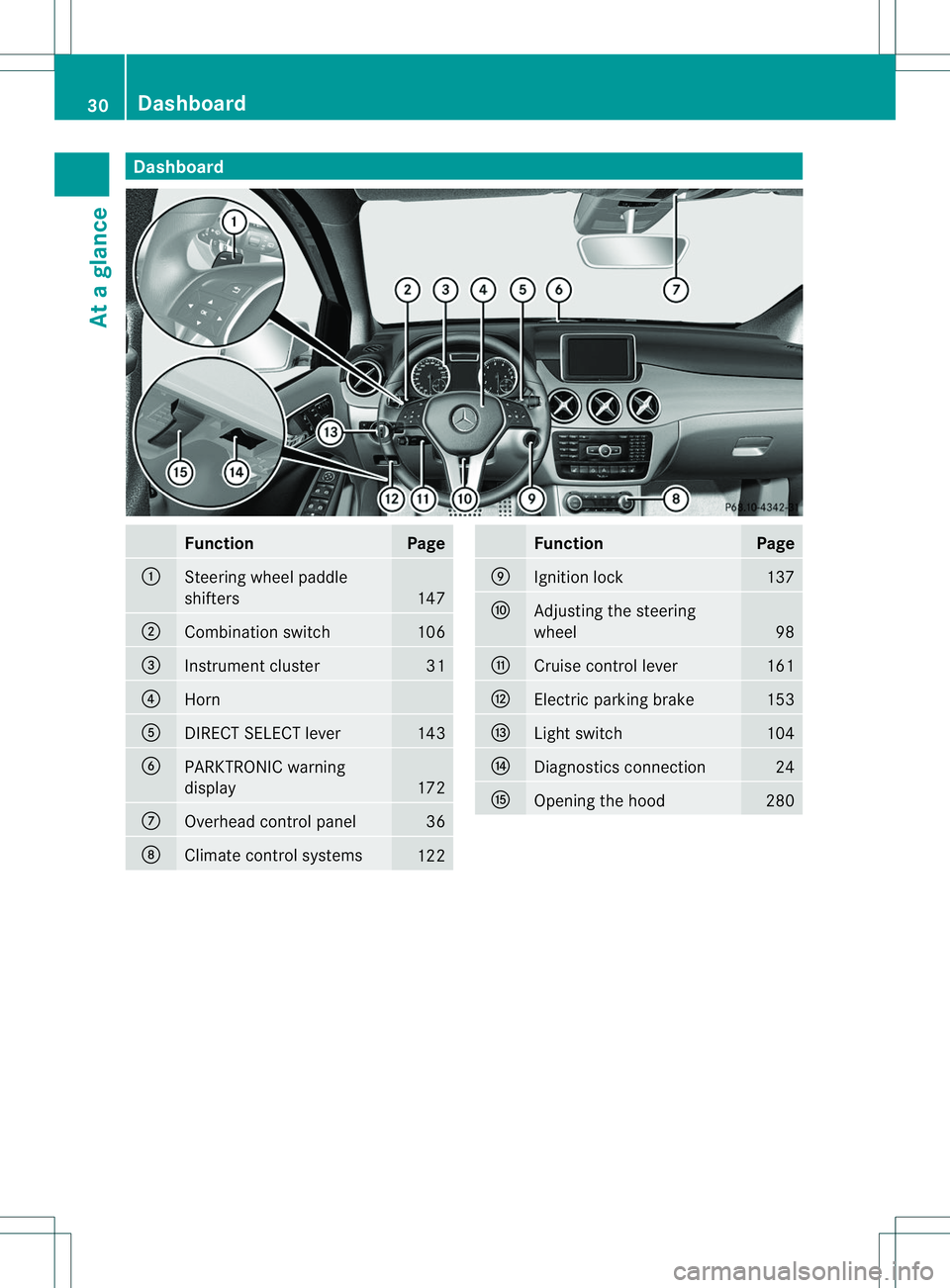
Dashboard
Function Page
001A
Steerin
gwhee lpaddle
shifters 147
0010
Combination switch 106
0023
Instrumen
tcluster 31
0021
Horn
001E
DIREC
TSELEC Tlever 143
0024
PARKTRONIC warning
display
172
0007
Overhead contro
lpanel 36
0008
Climat
econtrol systems 122 Function Page
0009
Ignition lock 137
0016
Adjustin
gthe steering
wheel 98
001D
Cruis
econtrol lever 161
0004
Electric parking brake 153
000B
Light switch 104
001C
Diagnostic
sconnection 24
000E
Opening th
ehood 28030
Dashboa
rdAtag lance
Page 42 of 360

Useful information
i This Operator's Manual describes all
models and all standard and optional
equipment of your vehicle available at the
time of publication of the Operator's
Manual. Country-specific differences are
possible. Please not ethat your vehicle may
not be equipped with all features
described. This also applies to safety-
related system sand functions.
i Read the information on qualified
specialist workshops: (Y page 25).Panic alarm
X
To activate: press0004button 001Afor at
least one second.
An alarm sounds and the exterior lighting
flashes.
X To deactivate: press0004button 001A
again.
or
X Insert the SmartKey int othe ignition lock. Occupant safety
Important safet
ynotes G
WARNING
Modifications to the restraint system scould
result in them not functioning properly any
more. The restraint system scould then no longer protect vehicle occupants as they are
designed to do and could fail in the even
tof
an acciden toractivat eunexpectedly, for
example. Ther eisanincreased risk of injury.
Never modify part softherestraint systems.
Do no tattemp ttomodify the wiring as well as
electronic components or their software.
If it is necessary to modify an air bag system
to accommodat eaperson with disabilities,
contact an authorized Mercedes-Benz center.
USA only: for further information contact our
Customer Assistance Center at
1-800-FOR-MERCedes (1800-367-6372).
In this section ,you will learn the most
important facts about the restraint system
components of the vehicle.
The restraint system consist sof:
R Seat belts
R Child restraint systems
R LATCH-type (ISOFIX) child seat securing
system
Additional protection is provided by:
R SRS (Supplemental Restraint System)
R Air bag system components with:
-PASSENGER AIR BAG OFF indicator lamp
- Front-passenger seat with Occupant
Classification System (OCS)
Although the systems are independent ,their
protective functions work in conjunction with
each other. Not all air bags are always
deployed in an accident.
i For information on infant sand children
traveling with you in the vehicle restraint
systems for infant sand children, see
"Children in the vehicle" (Y page 56). SRS (Supplemental Restraint System)
Introduction Supplemental Restraint System (SRS) with:
R
The 0021 SRS warning lamp
R Air bags 40
Occupant safetySafety
Page 43 of 360
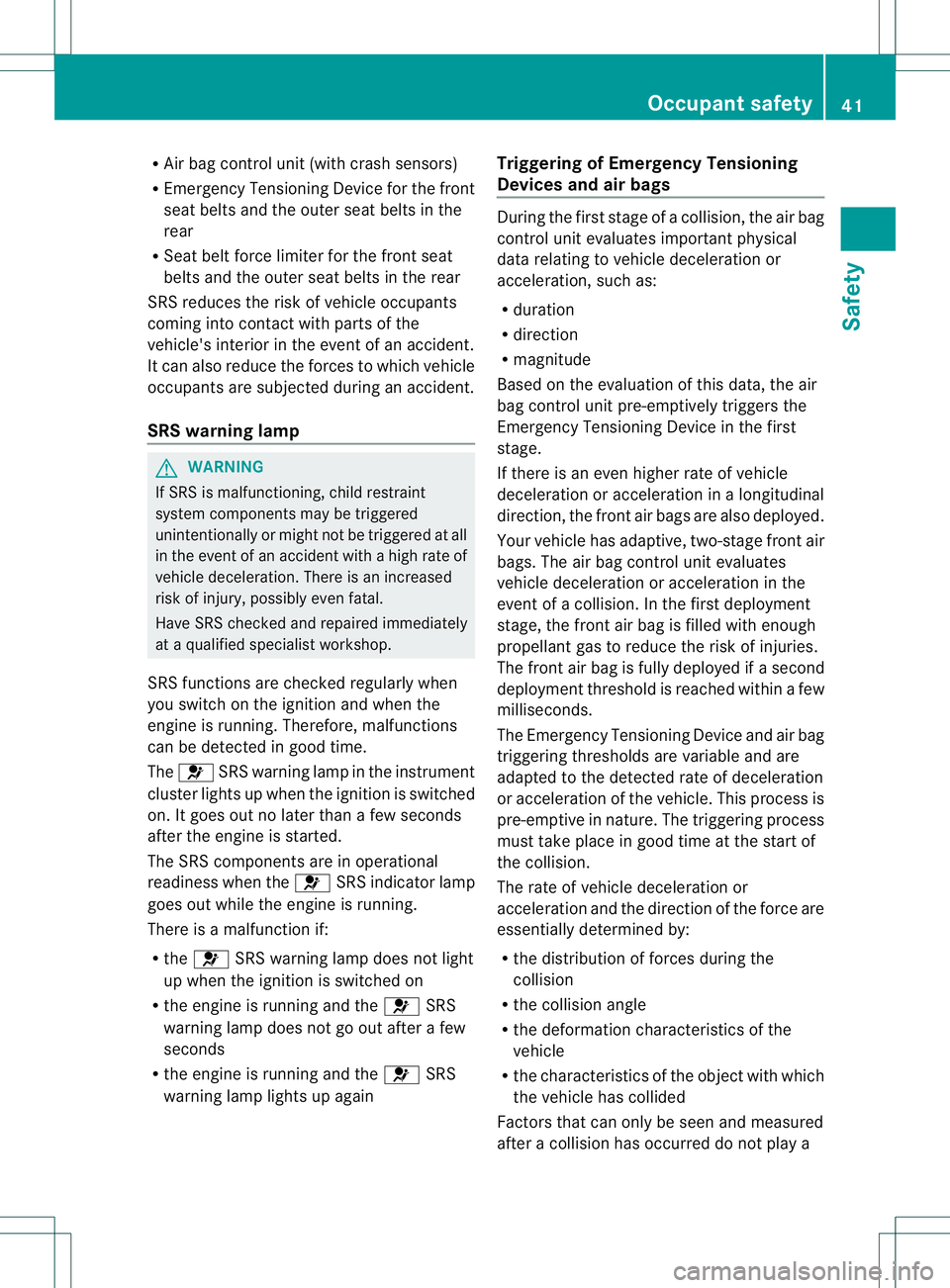
R
Air ba gcontro lunit( with crash sensors)
R Emergenc yTensioning Device for th efront
seat belt sand th eoute rseat belts in the
rear
R Seat belt forc elimiter for the fron tseat
belts and the outer seat belts in the rear
SRS reduces the risk of vehicle occupants
comin gintoc ontact with parts of the
vehicle's interior in the event of an accident.
It can also reduce the forces to which vehicle
occupants are subjected during an accident.
SRS warning lamp G
WARNING
If SRS is malfunctioning, child restraint
system component smay be triggered
unintentionally or might not be triggered at all
in the event of an acciden twith ahigh rate of
vehicle deceleration. There is an increased
risk of injury, possibly even fatal.
Have SRS checked and repaire dimmediately
at aq ualified specialist workshop.
SRS function sare checked regularly when
you switc honthe ignition and when the
engin eisrunning. Therefore, malfunctions
can be detected in good time.
The 0021 SRS warnin glamp in the instrument
cluster light supwhen the ignition is switched
on. It goes out no later than afew seconds
after the engin eisstarted.
The SRS component sare in operational
readiness when the 0021SRS indicator lamp
goes out while the engin eisrunning.
There is amalfunction if:
R the 0021 SRS warnin glamp does not light
up when the ignition is switched on
R the engin eisrunning and the 0021SRS
warnin glamp does not go out after afew
seconds
R the engin eisrunning and the 0021SRS
warnin glamp light supagain Triggering of Emergency Tensioning
Devices and air bags Durin
gthe firs tstag eofac ollision, the ai rbag
control unit evaluates important physical
dat arelating to vehicle deceleratio nor
acceleration, suc has:
R duration
R direction
R magnitude
Based on th eevaluation of this data, th eair
bag control unit pre-emptivel ytrigger sthe
Emergency Tensioning Devic einthefirst
stage.
If there is an eve nhigher rat eofvehicle
deceleratio noracceleration in alon gitudinal
direction, the front ai rbags are also deployed.
Your vehicle has adaptive, two-stag efront air
bags. The air bag control unit evaluates
vehicle deceleration or acceleration in the
even tofa collision. In the firs tdeployment
stage, the fron tair bag is filled with enough
propellan tgas to reduc ethe ri sk of injuries.
The front air bag is fully deployed if asecond
deploymen tthreshold is reached within afew
milliseconds.
The Emergency Tensioning Device and air bag
triggering thresholds are variable and are
adapted to the detected rate of deceleration
or acceleration of the vehicle. This process is
pre-emptive in nature. The triggering process
must take place in good time at the start of
the collision.
The rate of vehicle deceleration or
acceleration and the direction of the force are
essentially determined by:
R the distribution of forces during the
collision
R the collision angle
R the deformation characteristics of the
vehicle
R the characteristics of the object with which
the vehicle has collided
Factors that can only be seen and measured
after acollision has occurred do not play a Occupant safety
41Safety Z
Page 46 of 360
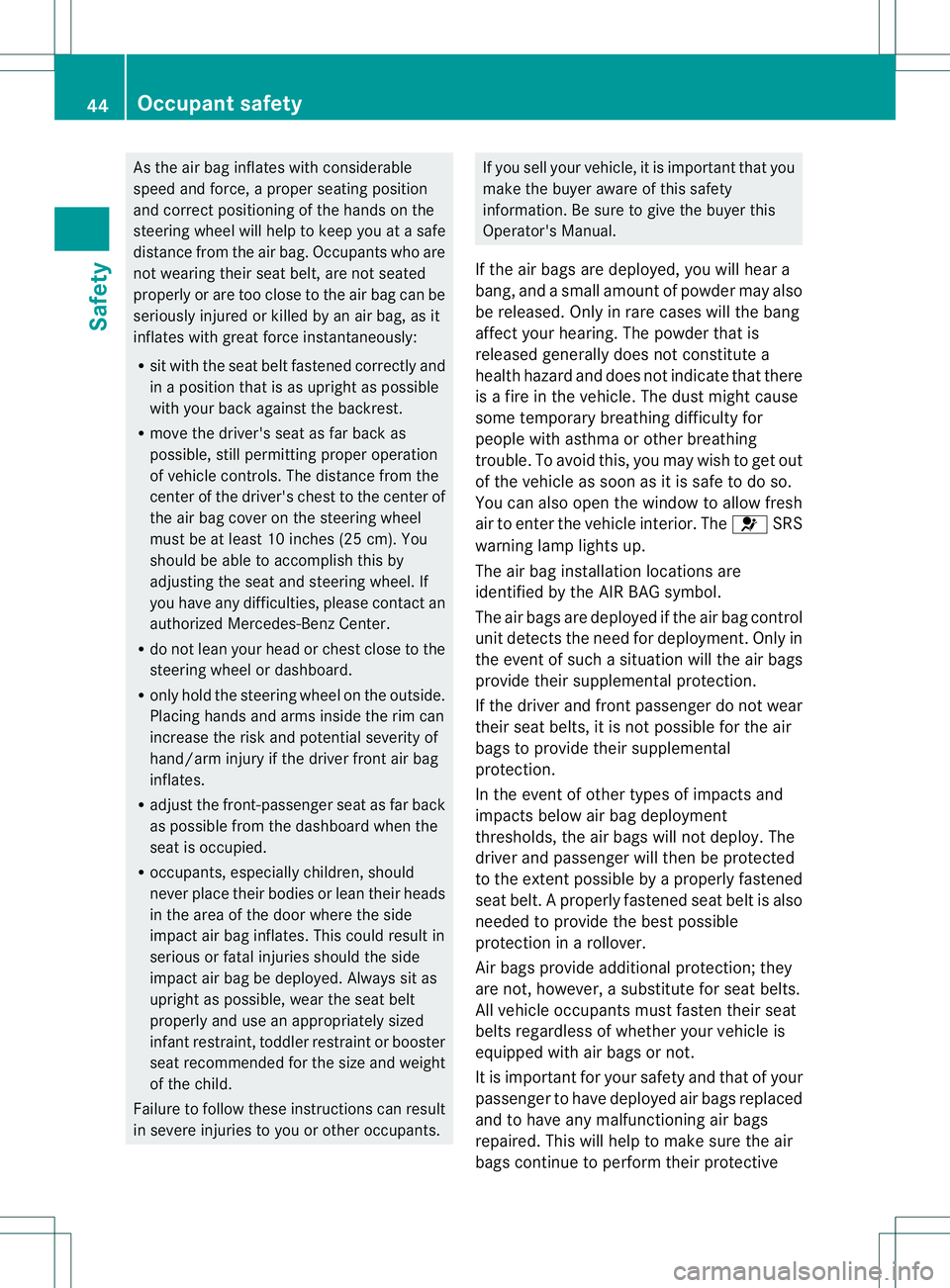
As the ai
rbag inflate swith considerable
spee dand force, aproper seating position
and correc tpositioning of th ehands on the
steering wheel will help to keep you at asafe
distanc efromt heair bag. Occupants who are
no tw earing their seat belt, are not seated
properly or are too close to the air bag can be
seriously injured or killed by an air bag, as it
inflates with great forc einstantaneously:
R sit with the seat belt fastened correctly and
in ap osition that is as upright as possible
with your back against the backrest.
R move the driver's seat as far back as
possible, still permitting proper operation
of vehicle controls. The distanc efrom the
center of the driver's chest to the center of
the air bag cover on the steerin gwheel
must be at least 10 inches (25 cm). You
should be able to accomplish this by
adjustin gthe seat and steerin gwheel. If
you have any difficulties, please contact an
authorized Mercedes-Benz Center.
R do not lean your head or chest close to the
steerin gwheel or dashboard.
R only hold the steerin gwheel on the outside.
Placing hands and arms inside the rim can
increase the risk and potential severit yof
hand/arm injury if the driver fron tair bag
inflates.
R adjust the front-passenger seat as far back
as possible from the dashboard when the
seat is occupied.
R occupants, especially children ,should
never place their bodies or lean their heads
in the area of the door where the side
impact air bag inflates .This could result in
serious or fatal injuries should the side
impact air bag be deployed. Always sit as
upright as possible, wear the seat belt
properly and use an appropriately sized
infant restraint,t oddler restraint or booster
seat recommended for the size and weight
of the child.
Failure to follow these instructions can result
in severe injuries to you or other occupants. If you sell your vehicle, it is important that you
make the buyer aware of this safety
information. Be sure to give the buyer this
Operator's Manual.
If the air bags are deployed, you will hear a
bang, and asmall amount of powder may also
be released. Only in rare cases will the bang
affect your hearing. The powder that is
released generally does not constitute a
health hazard and does not indicate that there
is af ire in the vehicle. The dust might cause
some temporary breathing difficulty for
people with asthma or other breathing
trouble. To avoid this, you may wish to get out
of the vehicle as soon as it is safe to do so.
You can also open the window to allow fresh
air to enter the vehicle interior. The 0021SRS
warning lamp lights up.
The air bag installation locations are
identified by the AIR BAG symbol.
The air bags are deployed if the air bag control
unit detects the need for deployment.O nly in
the event of such asituatio nwill the air bags
provide their supplemental protection.
If the drive rand front passenge rdonot wear
their seat belts, it is not possible for the air
bags to provide their supplemental
protection.
In the event of other types of impacts and
impacts below air bag deployment
thresholds, the air bags will not deploy. The
driver and passenger will then be protected
to the extentp ossible byaproperly fastened
seat belt. Aproperl yfastened seat beltisa lso
needed to provide the best possible
protection in arollover.
Air bags provide additional protection; they
are not, however, asubstitute for seat belts.
All vehicle occupants must fasten their seat
belts regardless of whether your vehicle is
equipped with air bags or not.
It is important for your safety and that of your
passenger to have deployed air bags replaced
and to have any malfunctioning air bags
repaired. This will help to make sure the air
bags continue to perform their protective 44
Occupant safetySafety
Page 51 of 360
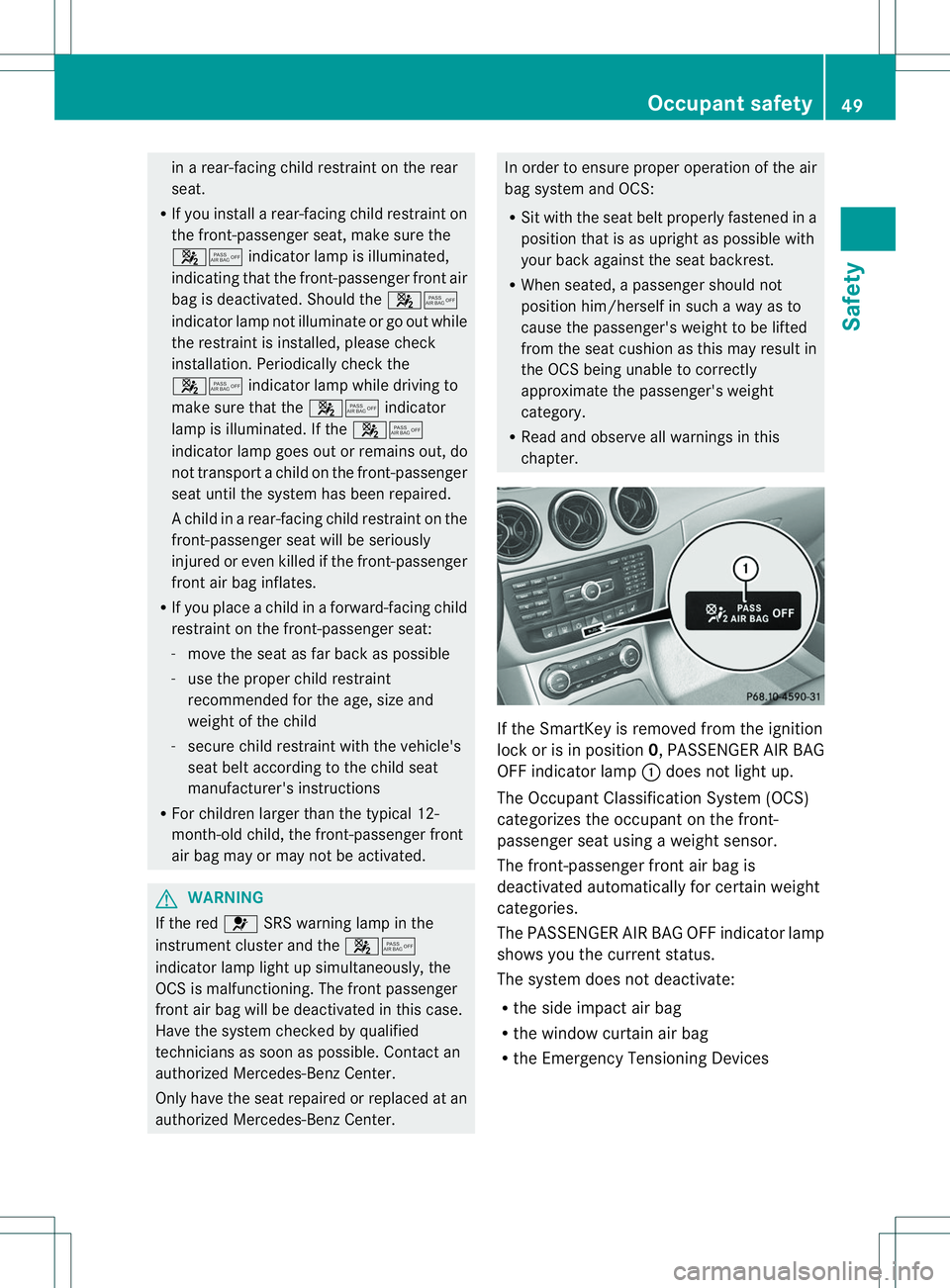
in
ar ear-facin gchild restraint on the rear
seat.
R If you install arear-facin gchild restraint on
the front-passenge rseat, make sure the
000E0013 indicator lamp is illuminated,
indicating that the front-passenger fron tair
bag is deactivated. Should the 000E0013
indicator lamp not illuminat eorgoout while
the restraint is installed, please check
installation .Periodically check the
000E0013 indicator lamp while driving to
make sure that the 000E0013indicator
lamp is illuminated. If the 000E0013
indicator lamp goes out or remains out, do
not transport achild on the front-passenger
seat until the system has been repaired.
Ac hild in arear-facing child restraint on the
front-passenger seat will be seriously
injured or even killed if the front-passenger
front air bag inflates.
R If you place achild in aforward-facing child
restraint on the front-passenger seat:
- move the seat as far back as possible
- use the proper child restraint
recommended for the age, size and
weight of the child
- secure child restraint with the vehicle's
seat belt according to the child seat
manufacturer's instructions
R For children larger than the typical 12-
month-old child, the front-passenger front
air bag may or may not be activated. G
WARNING
If the red 0021SRS warning lamp in the
instrument cluster and the 000E0013
indicator lamp light up simultaneously ,the
OCS is malfunctioning. The front passenger
front air bag will be deactivated in this case.
Have the system checked by qualified
technicians as soon as possible. Contact an
authorized Mercedes-Ben zCenter.
Only have the seat repaired or replaced at an
authorized Mercedes-Benz Center. In order to ensure proper operation of the air
bag system and OCS:
R
Sit with the seat belt properly fastened in a
position that is as upright as possible with
your back against the seat backrest.
R When seated, apassenger should not
position him/herself in such away as to
cause the passenger' sweight to be lifted
from the seat cushion as this may result in
the OCS being unable to correctly
approximat ethe passenger' sweight
category.
R Read and observe all warnings in this
chapter. If the SmartKey is removed from the ignition
lock or is in position 0,PASSENGER AIR BAG
OFF indicator lamp 001Adoes not light up.
The Occupant Classification System (OCS)
categorize sthe occupant on the front-
passenge rseat using aweight sensor.
The front-passenger fron tair bag is
deactivated automatically for certain weight
categories.
The PASSENGER AI RBAG OFF indicator lamp
shows yo uthe current status.
The system does not deactivate:
R the side impact ai rbag
R thew indow curtain air bag
R theE me rgency Tensioning Devices Occupant safety
49Safety Z
Page 52 of 360

To be classified correctly, the frontp
assenger
must sit:
R wit hthe seat belt fastened correctly
R in ap ositio nthat is as upright as possible
with their back against the seat backrest
R with their feet on the floor
The OCS weight sensor reading is affected if
the occupant's weight is transferred, e.g. by
leaning on the armrest.
If the front-passenger seat, the seat cover or
the seat cushion are damaged, have the
necessary repair work carried out at a
qualified specialist workshop.
For safety reasons, Mercedes-Benz
recommends that you only use seat
accessories that have been approved by
Mercedes-Benz.
Both the driver and the front passenger
should always observe the PASSENGER AIR
BAG OFF indicator lamp as an indication of
whether or not the front passenger is
positioned correctly. Observe also the air bag
displaym essages that can be displayed in the
instrumentc luster (Ypage 219).
If the driver's air bag deploys, this does not
mean that the front-passenger front air bag
will also deploy.
The OCS may have detected that the seat:
R is empty or occupied by the weight of a
typical child up to twelve months old,
seated in achild restraint system.
R is occupied by asmall individual, such as a
young teenager or asmall adult.
R is occupied by achild in achild restraint
system whose weight is greater than that
of at ypical twelve montho ld child.
These are examples of when the OCS
deactivates the front-passenger front air bag.
Deactivation takes place although the
collision fulfills the criteria for deploying the
driver's air bag.
For further information ,see "Air bag display
messages" (Y page 219). System self-test G
WARNING
If the 000E0013indicator lamp does not
illuminate, the system is not functioning. You
must contac tanauthorized Mercedes-Benz
Center befor eseatin gany child on the front
passenger seat. G
WARNING
Never place anything betwee nseat cushion
and child seat (e.g. apillow), since it reduces
the effectiveness of the OCS. The underside
and rear side child restraint system must be
placed entirely on the seat cushion and the
backrest of the front-passenger seat
backrest.
If necessary, adjust the tilt of the passenger
seat backrest.
An incorrectly mounted child seat could cause
injuries to the child in case of an accident,
instead of increasing protection for the child.
Follow the manufacturer's instructions for
installation of child restraint systems.
The PASSENGER AIR BAG OFF indicator lamp
lights up:
R if you turn the SmartKey in the ignition lock
to position 1or 2
R if an adult is seated properly on the front-
passenger seat and the OCS classifies the
occupant as an adult
The PASSENGER AIR BAG OFF indicator
lamp goes out again after approximately six
seconds.
If the seat is not occupied and the OCS
detects that the front-passenger seat is
empty, the PASSENGER AIR BAG OFF
indicator lamp will continue to light up. The
PASSENGER AIR BAG OFF indicator lamp
will not go out.
For further information ,see "Problems with
the Occupant Classification System"
(Y page 51). 50
Occupant safetySafety
Page 53 of 360

Problems with the Occupant Classification System
Problem Possible causes/consequences and
000B Solutions
The PASSENGER AIR
BAG OFF indicator
lights up and remains
on.
The person on the
front-passenger seat:
R
has the weight of a
typical adult
R has been determined
by the system not to
be achild The OCS is malfunctioning.
X
Make sure that the front passenger is sittinginac orrect, upright
position.
X Have the OCS checked as soon as possible at aqualified
specialist workshop.
X Observe the additional display messages in the multifunction
display (Y page 219). G
WARNING
If the 000E0013 indicator lamp illuminates and remains illuminated when the weight of atypical
adult or someone larger than asmall individual has been detected on the passenger seat, do not
allow any occupant to use the passenger seat until the system has been repaired. Problem Possible causes/consequences and
000B Solutions
The PASSENGER AIR
BAG OFF indicator
lamp does not light up
and/or stays on.
The front-passenger
seat is:
R
unoccupied
R occupied with the
weight of achild up
to twelve months old
in ac hild restraint
system The OCS is malfunctioning.
X
Make sure there is nothingb etween the seat cushion and the
child seat.
X Make sure that the backrest and base of the child restraint
system are resting securely on the front-passenger seat. If
necessary, adjust the position of the front-passenger seat.
X When installing the child restraint system, make sure that the
seat belt is tight. Do not pull the seat belt tight with the front-
passenger seat adjustment .This could result in the seat belt
being pulledt oo tightly.
X Check the installation of the child restraint system.
X Make sure that no objectsa re applying additionalweight onto
the seat.
X If the PASSENGER AIR BAG OFF indicator lamp remains off, have
the OCS checked immediatel yataqualified specialist
workshop. Do not transport achild on the front-passenger seat
until the OCS has been repaired.
X Observ ethe additional display messages in the multifunction
display ( Ypage 219). Occupant safety
51Safety Z
Page 57 of 360
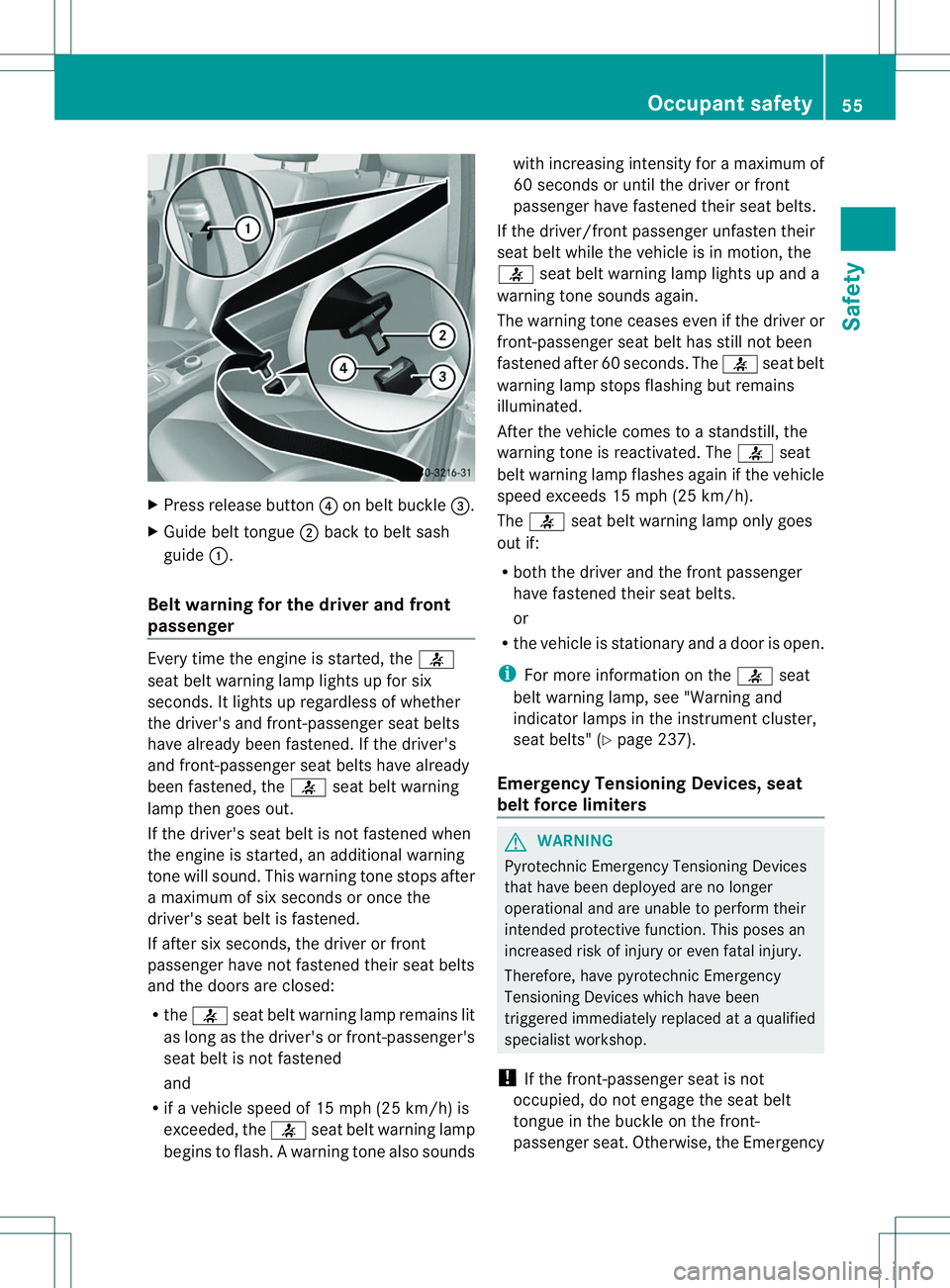
X
Press release button 0021on belt buckle 0023.
X Guide belt tongue 0010back to belt sash
guide 001A.
Belt warning for the driver and front
passenger Everyt
ime the engine is started, the 0020
seat belt warning lamp lights up for six
seconds. It lights up regardless of whether
the driver's and front-passenger seat belts
have already been fastened. If the driver's
and front-passenger seat belts have already
been fastened, the 0020seat belt warning
lamp then goes out.
If the driver's seat belt is not fastened when
the engine is started, an additional warning
tonew ill sound. This warning tones tops after
am aximum of six seconds or once the
driver's seat belt is fastened.
If after six seconds, the driver or front
passenger have not fastened their seat belts
and the doors are closed:
R the 0020 seat belt warning lamp remains lit
as long as the driver's or front-passenger's
seat belt is not fastened
and
R ifav ehicle speed of 15 mph (25 km/h) is
exceeded, the 0020seat belt warning lamp
begins to flash. Awarning tone also sounds wit
hincreasing intensit yfor am aximum of
60 seconds or until th edriver or front
passenger have fastened their seat belts.
If th edriver/fron tpassenger unfasten their
seat belt while th evehicle is in motion ,the
0020 seat belt warning lamp light supand a
warning tone sounds again.
The warning tone ceases eve nifthe driver or
front-passenger seat belt has still not been
fastened after 60 seconds. The 0020seat belt
warning lamp stops flashing but remains
illuminated.
After the vehicle comes to astandstill, the
warning tone is reactivated. The 0020seat
belt warning lamp flashes again if the vehicle
speed exceeds 15 mph (25 km/h).
The 0020 seat belt warning lamp only goes
out if:
R both the driver and the front passenger
have fastened their seat belts.
or
R the vehicle is stationary and adoor is open.
i For more information on the 0020seat
belt warning lamp, see "Warning and
indicator lamps in the instrumentc luster,
seat belts" (Y page 237).
Emergency Tensioning Devices, seat
belt force limiters G
WARNING
Pyrotechnic Emergency Tensioning Devices
that have been deployed are no longer
operational and are unable to perform their
intended protective function. This poses an
increased risk of injury or even fatal injury.
Therefore, have pyrotechnic Emergency
Tensioning Devices which have been
triggered immediately replaced at aqualified
specialist workshop.
! If the front-passenger seat is not
occupied, do not engage the seat belt
tongue in the buckle on the front-
passenger seat. Otherwise, the Emergency Occupant safety
55Safety Z